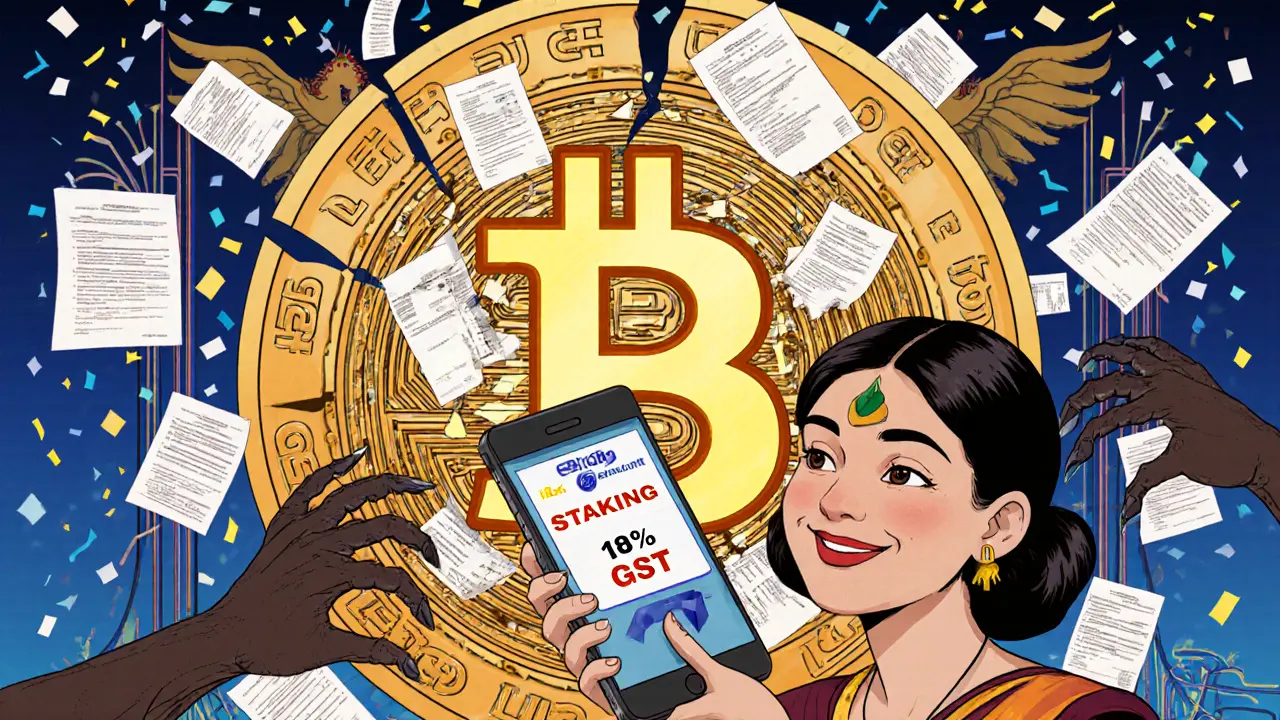India Crypto Tax Calculator
Calculate Your Tax Burden
Enter your transaction details to see how India's tax rules impact your crypto gains.
India is the number one country in the world for cryptocurrency adoption-and it’s doing it while taxing digital assets like gambling winnings. While most nations are trying to attract crypto businesses with friendly rules, India slapped on one of the strictest tax systems on the planet. And yet, millions of Indians are still buying, selling, and holding Bitcoin, Ethereum, and other tokens. How? And why hasn’t the tax crackdown killed the market?
How India Became the World’s Top Crypto Market
In 2025, over 120 million Indians own cryptocurrency. That’s more than the entire population of Germany. It’s not because the government encouraged it. In fact, the Reserve Bank of India warned against crypto for years. But when banks blocked crypto transactions in 2018, people found workarounds-peer-to-peer apps, offshore exchanges, local trading groups. When the Supreme Court lifted the banking ban in 2020, adoption exploded. By 2023, India accounted for nearly 25% of all global peer-to-peer crypto trades. Today, it’s the top market for Bitcoin purchases on platforms like Paxful and LocalBitcoins.What’s driving this? Young professionals, students, and gig workers see crypto as a way out of inflation and low returns on savings. With fixed deposits earning just 6-7% and the rupee losing value, crypto feels like the only real chance to grow wealth. A 2025 survey by CoinSwitch showed that 68% of Indian crypto users started because they wanted to protect their savings-not to gamble or speculate.
The Tax System That Should Have Killed Crypto
Here’s where it gets strange. In 2022, India introduced a tax regime that’s almost designed to scare people away. All cryptocurrency gains are taxed at a flat 30%. No deductions. No loss offsets. Even if you lost ₹5 lakh on Bitcoin and made ₹1 lakh on Solana, you still pay 30% on that ₹1 lakh. No exceptions.On top of that, every trade over ₹50,000 triggers a 1% Tax Deducted at Source (TDS). That means if you buy ₹1 lakh worth of Ethereum, ₹1,000 is automatically taken by the exchange and sent to the tax department-even if you haven’t sold it yet. You can’t get that money back unless you file a refund, which takes months. For frequent traders, this drains cash flow fast.
Then came the 18% GST in July 2025. Now, every fee you pay-trading fees, withdrawal charges, staking rewards, even custody fees-is taxed like a service. If you use Binance or CoinDCX to stake your tokens and earn 5% APY, the platform takes 18% of your rewards as GST. That’s not just a tax on profit-it’s a tax on participation.
Compare that to the U.S., where long-term crypto gains are taxed at 15-20%, and losses can offset gains. Or to Portugal, where crypto profits are tax-free. India’s system is unique: it treats digital assets like lottery tickets, not investments.

Why People Still Trade Despite the Tax
If this tax system was logical, crypto trading in India would have collapsed. But it didn’t. Why?First, the market is too big to stop. With over 120 million users, crypto is now part of India’s financial culture. It’s not just tech-savvy millennials-teachers, drivers, shopkeepers are buying small amounts through UPI-linked apps like ZebPay and CoinSwitch. They don’t care about tax forms. They care about getting ahead.
Second, the 1% TDS creates a false sense of compliance. Many users think, “The exchange already took tax, so I’m good.” They don’t realize they still need to report everything in Schedule VDA of their Income Tax Return. The government assumes TDS = tax paid. But it’s not. TDS is just a withholding. You still owe the full 30% if you made a profit. And if you lost money? You still paid TDS. No refund.
Third, offshore exchanges fill the gap. Platforms like Binance, Bybit, and OKX don’t collect Indian TDS or GST. So traders use P2P to buy crypto with INR, then move it offshore. The government can track UPI transfers, but once crypto leaves India, it’s hard to follow. This has created a parallel market-legal on the way in, unregulated on the way out.
The Hidden Cost of the Tax
The real damage isn’t in the tax revenue-it’s in what’s being lost.Indian crypto startups are leaving. Companies like ZebPay and CoinSwitch have slowed hiring. Some developers are moving to Dubai and Singapore, where crypto is welcomed. The 18% GST forced many small exchanges to shut down because they couldn’t handle the compliance burden. Only big players with legal teams survive.
Traders are stuck in a nightmare of record-keeping. Every transaction-buy, sell, swap, stake-must be tracked. Cost of acquisition? Must be documented. Date? Timestamp? Platform? All needed for Schedule VDA. No software in India can fully automate this. Most people use spreadsheets or pay accountants ₹10,000+ per year just to file taxes.
And here’s the irony: the government collects less than expected. In FY 2024-25, crypto tax revenue came in at ₹2,800 crore-far below the ₹8,000 crore projected. Why? Because most gains go unreported. The 1% TDS is collected, but the 30% tax on net profit? Only 1 in 5 filers actually declare it. The rest rely on the system’s weak enforcement.

Is Change Coming?
In August 2025, the Central Board of Direct Taxes (CBDT) sent out questionnaires to every major Indian crypto exchange. They asked: Is the 1% TDS too much? Should we allow loss offsets? Is the 30% rate killing liquidity? Are offshore platforms hurting India’s economy?That’s the first sign the government knows something’s broken. Industry leaders are pushing for three changes:
- Allow losses to offset gains within the same asset class
- Remove TDS on purchases and only apply it on sales
- Exempt staking and DeFi rewards from GST
There’s also talk of creating a separate legal category for crypto-not just as a “Virtual Digital Asset,” but as a new asset class with its own rules. That could mean clearer reporting, lower compliance costs, and maybe even lower tax rates for long-term holders.
But change won’t come fast. The Finance Ministry still sees crypto as a risk-not an opportunity. They worry about money laundering, capital flight, and youth gambling. But the data shows something else: Indians aren’t gambling. They’re saving. And they’re doing it despite the system trying to stop them.
What This Means for the Future
India’s crypto story isn’t about regulation. It’s about resilience. The government built a wall. People climbed over it. They didn’t need permission. They didn’t wait for approval. They just started using crypto because it worked for them.That’s why India leads the world in adoption. Not because it’s easy. But because it’s necessary.
By 2026, if the tax rules don’t change, India might lose its top spot. Traders will move to countries with fairer systems. Startups will vanish. Innovation will die. But the people? They’ll keep trading. They always do.
The real question isn’t whether India can control crypto. It’s whether it wants to.
Why is India #1 in crypto adoption despite high taxes?
India leads because millions of people see crypto as a way to protect savings from inflation and low bank returns. Even with a 30% tax, 1% TDS, and 18% GST, people still buy crypto through UPI and P2P platforms. The demand is driven by necessity, not speculation. With over 120 million users, the market is too large to stop-even with strict rules.
What is the 30% crypto tax in India?
The 30% tax applies to all profits from selling or trading cryptocurrencies and NFTs. It’s a flat rate with no deductions. You can’t reduce your taxable gain by subtracting trading fees, mining costs, or losses from other crypto assets. Even if you lost money overall, you still pay 30% on every profit you made. The government treats crypto gains like lottery winnings.
What is the 1% TDS on crypto in India?
The 1% Tax Deducted at Source (TDS) is taken automatically by Indian exchanges whenever you buy or sell crypto worth more than ₹50,000 in a single transaction. This money goes to the government right away, even if you didn’t make a profit. You can only claim it back if you file for a refund during tax season, which is rare. It’s a cash flow killer for active traders.
Is GST applied to crypto transactions in India?
Yes. Since July 2025, an 18% Goods and Services Tax (GST) applies to all platform services-including trading fees, withdrawal charges, staking rewards, and custody fees. This means if you earn staking rewards or pay a fee to trade, 18% of that amount is taken as tax. It’s not on the crypto itself, but on the service you use to interact with it.
Can I offset crypto losses against gains in India?
No. Under current rules, you cannot use losses from one crypto asset to reduce taxes on gains from another. Even if you lost ₹2 lakh on Bitcoin and made ₹1 lakh on Ethereum, you still pay 30% tax on the ₹1 lakh. Losses cannot be carried forward to future years either. This makes trading risky and costly during market downturns.
Are Indian crypto exchanges shutting down because of taxes?
Yes. Many small exchanges and startups have closed or scaled back because of the 18% GST and complex TDS compliance. Only large platforms with legal teams can afford to operate. The cost of reporting every transaction, maintaining KYC/AML records, and handling GST registration has made it nearly impossible for smaller players to survive.
Is India planning to change its crypto tax rules?
Yes. In August 2025, India’s tax board (CBDT) began consulting with crypto companies to review the current system. They’re asking whether the 1% TDS is too high, if the 30% tax is killing liquidity, and whether offshore exchanges are gaining unfair advantages. While no changes have been announced, this is the first serious sign the government is open to reform.




Emily Unter King
November 4, 2025 AT 12:29The 30% flat tax on crypto gains is a regulatory nightmare-no loss harvesting, no deductions, not even for transaction fees. It’s a vestigial tax policy designed for lottery winnings, not decentralized assets. The 1% TDS on purchases is even more absurd: it’s a liquidity tax that penalizes entry, not profit. This isn’t taxation-it’s financial obstructionism.
Michelle Sedita
November 5, 2025 AT 00:42It’s fascinating how India’s crypto adoption defies economic logic. Most nations try to attract capital with regulatory clarity-but India built a labyrinth and people still found the exit. This isn’t about speculation. It’s about a generation realizing that the formal financial system isn’t designed for them. Crypto isn’t an alternative-it’s the only functional option left.
Cydney Proctor
November 6, 2025 AT 16:50Of course Indians are buying crypto-they have no other way to preserve wealth. The rupee’s depreciation isn’t a bug, it’s a feature of a broken state. And yet, the government acts like they’re doing something clever by taxing it like a casino. The real scandal isn’t crypto adoption-it’s that this level of financial repression is considered normal.
Cierra Ivery
November 8, 2025 AT 00:11Wait-so you’re saying people are STILL buying crypto despite the 18% GST on staking rewards? And the 1% TDS on every purchase? And the fact that losses CANNOT be offset? That’s not resilience-that’s desperation. And the government’s response? More bureaucracy. More forms. More penalties. This isn’t policy. It’s punishment.
Veeramani maran
November 9, 2025 AT 05:26bro i am from delhi and i trade on coinswitch daily... the 1% tds is nightmare but we still do it because bank intrest is 6.5% and inflation is 11%... i use upi to buy and then send to binance... dont care about tax form... i just want my money to not vanish
Kevin Mann
November 10, 2025 AT 10:57OKAY SO LET ME BREAK THIS DOWN BECAUSE THIS IS THE MOST DRAMATIC THING I’VE READ ALL YEAR. Imagine this: You’re trying to grow your money, right? But the government says, ‘Nope, if you make even one rupee profit, we take 30%. And if you lose money on Bitcoin but make a dime on Solana? STILL 30%. And if you try to stake? 18% GST ON THE REWARDS. And if you buy? 1% TDS TAKEN BEFORE YOU EVEN BREATHE. And yet-120 MILLION PEOPLE STILL DO IT. This isn’t a market. This is a rebellion. A silent, crypto-powered, UPI-fueled revolution against a system that forgot how to serve its people. And the government? They’re still counting the TDS like it’s a win. But they’re not seeing the exodus. The developers leaving. The startups vanishing. The people who just want to save, not be taxed like criminals. This isn’t policy. This is a slow-motion national tragedy wrapped in a tax code.